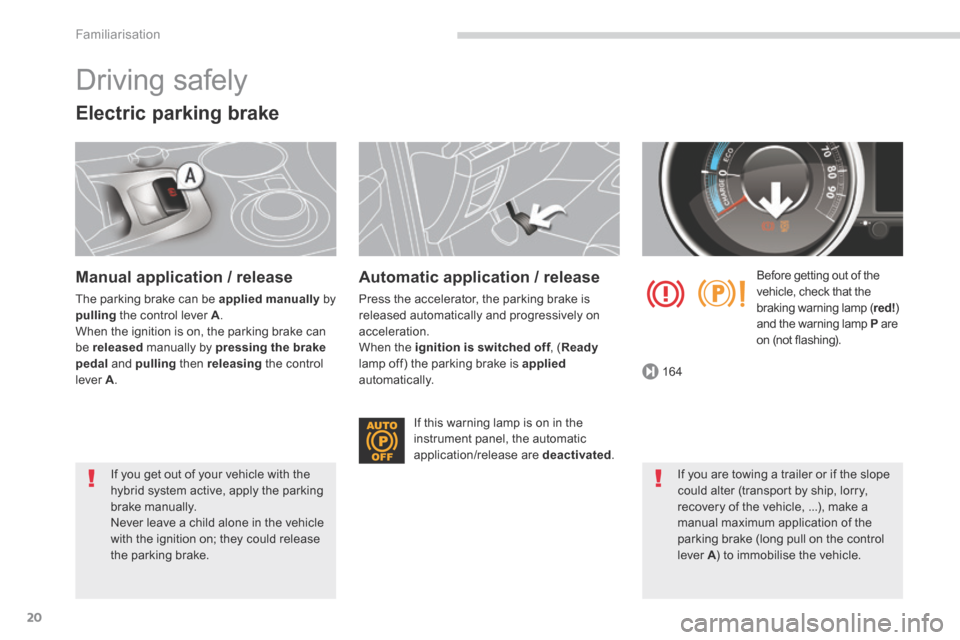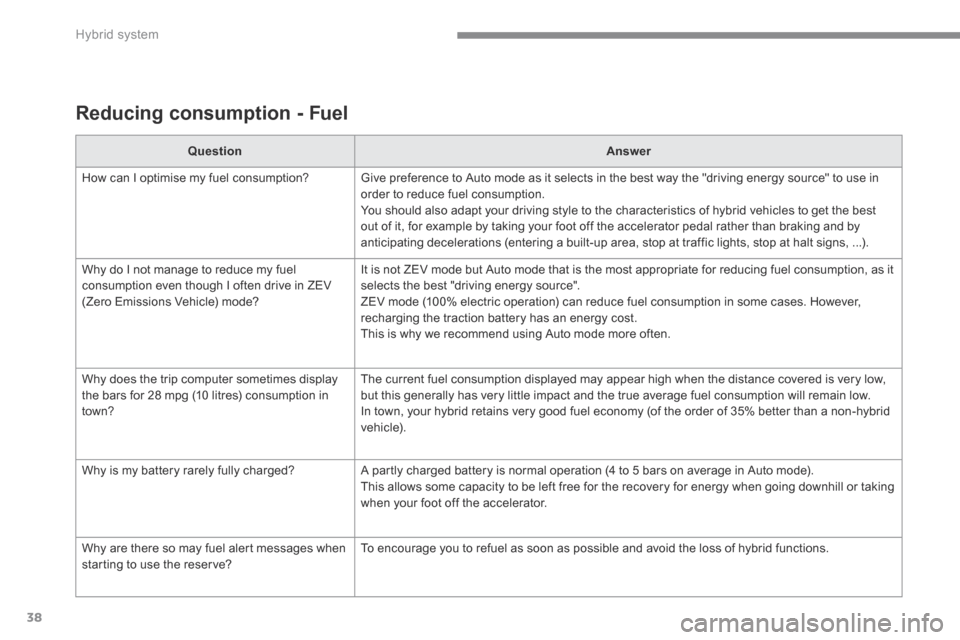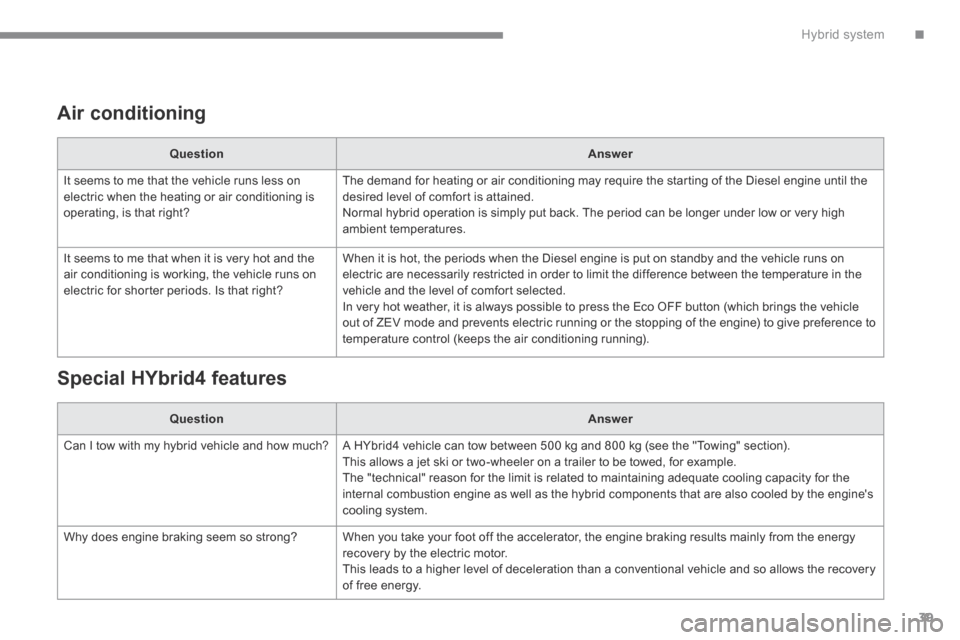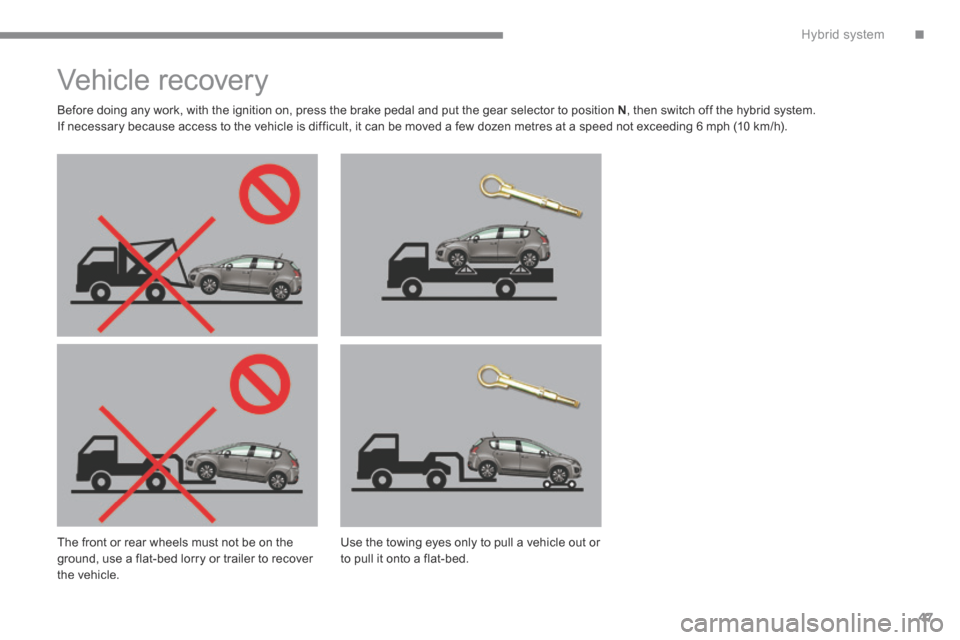2014 Peugeot 3008 Hybrid 4 tow
[x] Cancel search: towPage 5 of 378

.
.
Contents
Direction indicators 151Hazard warning lamps 151H o r n 151Tyre under-infl ation detection 152ESC system 154Front seat belts 157Airbags 160
Safety
Electric parking brake 164Hill start assist 168Head-up display 171Speed limiter 173Cruise control 176Electronic gearbox 179Parking sensors 183Reversing camera 185Parking space sensors 186
Driving
Emergency or assistance 241PEUGEOT Connect Media Navigation (NG4 3D) 245PEUGEOT Connect Navigation (RT6) 289PEUGEOT Connect Sound (RD5) 343
Audio equipment and telematics
Alphabetical indexVisual search
Bonnet 189Running out of fuel (Diesel) 190Diesel engine 191Checking levels 192Checks 195
Checks
Temporary puncture repair kit 197Changing a wheel 203Snow chains 208Changing a bulb 209Changing a fuse 21412 V battery 221Energy economy mode 225Changing a wiper blade 226Recovering the vehicle 227Vehicle recovery 228Towing a trailer 229Fitting roof bars 231Very cold climate screen 232Accessories 233
Practical information
Electric motor 235Diesel engine 236Diesel weights 237Dimensions 238Identifi cation markings 239
Technical data
Page 22 of 378

164
Familiarisation
20
Driving safely
Electric parking brake
Manual application / release
The parking brake can be applied manually by pulling the control lever A . When the ignition is on, the parking brake can be released manually by pressing the brake pedal and pulling then releasing the control lever A .
Automatic application / release
Press the accelerator, the parking brake is released automatically and progressively on acceleration. When the ignition is switched off , ( ignition is switched off , ( ignition is switched offReadylamp off) the parking brake is appliedautomatically.
Before getting out of the vehicle, check that the braking warning lamp ( red! ) and the warning lamp P are on (not flashing).
If this warning lamp is on in the instrument panel, the automatic application/release are deactivated .
If you get out of your vehicle with the hybrid system active, apply the parking brake manually. Never leave a child alone in the vehicle with the ignition on; they could release the parking brake.
If you are towing a trailer or if the slope could alter (transport by ship, lorry, recovery of the vehicle, ...), make a manual maximum application of the parking brake (long pull on the control lever A ) to immobilise the vehicle. A ) to immobilise the vehicle. A
Page 40 of 378

Hybrid system
38
Reducing consumption - Fuel
QuestionAnswer
How can I optimise my fuel consumption? Give preference to Auto mode as it selects in the best way the "driving energy source" to use in order to reduce fuel consumption. You should also adapt your driving style to the characteristics of hybrid vehicles to get the best out of it, for example by taking your foot off the accelerator pedal rather than braking and by anticipating decelerations (entering a built-up area, stop at traffic lights, stop at halt signs, ...).
Why do I not manage to reduce my fuel consumption even though I often drive in ZEV (Zero Emissions Vehicle) mode?
It is not ZEV mode but Auto mode that is the most appropriate for reducing fuel consumption, as it selects the best "driving energy source". ZEV mode (100% electric operation) can reduce fuel consumption in some cases. However, recharging the traction battery has an energy cost. This is why we recommend using Auto mode more often.
Why does the trip computer sometimes display the bars for 28 mpg (10 litres) consumption in town?
The current fuel consumption displayed may appear high when the distance covered is very low, but this generally has very little impact and the true average fuel consumption will remain low. In town, your hybrid retains very good fuel economy (of the order of 35% better than a non-hybrid vehicle).
Why is my battery rarely fully charged? A partly charged battery is normal operation (4 to 5 bars on average in Auto mode). This allows some capacity to be left free for the recovery for energy when going downhill or taking when your foot off the accelerator.
Why are there so may fuel alert messages when starting to use the reserve? To encourage you to refuel as soon as possible and avoid the loss of hybrid functions.
Page 41 of 378

.Hybrid system39
Air conditioning
QuestionAnswer
It seems to me that the vehicle runs less on electric when the heating or air conditioning is operating, is that right?
The demand for heating or air conditioning may require the starting of the Diesel engine until the desired level of comfort is attained. Normal hybrid operation is simply put back. The period can be longer under low or very high
ambient temperatures.
It seems to me that when it is very hot and the air conditioning is working, the vehicle runs on electric for shorter periods. Is that right?
When it is hot, the periods when the Diesel engine is put on standby and the vehicle runs on electric are necessarily restricted in order to limit the difference between the temperature in the vehicle and the level of comfort selected. In very hot weather, it is always possible to press the Eco OFF button (which brings the vehicle out of ZEV mode and prevents electric running or the stopping of the engine) to give preference to temperature control (keeps the air conditioning running).
Special HYbrid4 features
QuestionAnswer
Can I tow with my hybrid vehicle and how much? A HYbrid4 vehicle can tow between 500 kg and 800 kg (see the "Towing" section). This allows a jet ski or two-wheeler on a trailer to be towed, for example. The "technical" reason for the limit is related to maintaining adequate cooling capacity for the internal combustion engine as well as the hybrid components that are also cooled by the engine's cooling system.
Why does engine braking seem so strong? When you take your foot off the accelerator, the engine braking results mainly from the energy recovery by the electric motor. This leads to a higher level of deceleration than a conventional vehicle and so allows the recovery
of free energy.
Page 42 of 378

Hybrid system
40
Eco-driving suited to your
HYbrid4 vehicle
Use gear selector position A , as this optimises gear changes to suit the circumstances, and the AUTO mode of the HYbrid4 mode selector. When moving off, accelerate normally up to the desired speed ( POWER zone between 20 and 40 %). At steady speeds, drive gently with small movements of the accelerator pedal ( ECO or CHARGE zone), run in electric mode as often as possible when driving at low speed. Anticipate the need to slow down and use engine braking ( CHARGE zone), so as to make use of free energy recovery while keeping light pressure on the accelerator pedal.
Control the use of your electrical equipment
Before moving off, if the passenger compartment is too warm, ventilate it by opening the windows and air vents before using the air conditioning. Above 30 mph (50 km/h), close the windows and leave the air vents open. Remember to make use of equipment that can help keep the temperature in the passenger compartment down (sun roof and window blinds...). Switch off the air conditioning, unless it has automatic digital regulation, as soon as the desired temperature is attained. Switch off the demisting and defrosting controls, if not automatic. Switch off the heated seat as soon as possible.
As a passenger, if you avoid connecting your multimedia devices (film, music, video game...), you will contribute towards limiting the consumption of electrical energy, and so of fuel. Disconnect your portable devices before leaving the vehicle.
Eco-driving
Eco-driving is a range of everyday practices that allow the motorist to optimise their fuel consumption and CO2 emissions.
Avoid running the Diesel engine when stationary, particularly in winter; your vehicle will warm up much faster while driving.
Switch off the headlamps and front foglamps when the level of light does not require their use.
Page 49 of 378

.Hybrid system47
Vehicle recover y
Before doing any work, with the ignition on, press the brake pedal and put the gear selector to position N , then switch off the hybrid system. If necessary because access to the vehicle is difficult, it can be moved a few dozen metres at a speed not exceeding 6 mph (10 km/h).
The front or rear wheels must not be on the ground, use a flat-bed lorry or trailer to recover the vehicle.
Use the towing eyes only to pull a vehicle out or to pull it onto a flat-bed.
Page 53 of 378

1
Monitoring51
Operation indicator lamps
If one of the following indicator lamps comes on, this confirms that the corresponding system has come into operation.
Warning lampis onCauseAction / Observations
Left-hand
direction indicator
flashing with buzzer. The lighting stalk is pushed down.
Right-hand direction indicator
flashing with buzzer. The lighting stalk is pushed up.
Sidelamps fixed. The lighting stalk is in the "Sidelamps" position.
Dipped beam headlamps fixed. The lighting stalk is in the "Dipped beam headlamps" position.
Main beam headlamps fixed. The lighting stalk is pulled towards you. Pull the stalk to return to dipped beam headlamps.
Ready fixed. The vehicle is ready to move off; you can press the accelerator. It comes on once high voltage is established in the vehicle.
Front foglamps fixed. The front foglamps are switched on. Turn the ring on the stalk rear wards twice to switch off the front foglamps.
Rear foglamps fixed. The rear foglamps are switched on. Turn the ring on the stalk rear wards to switch off the rear foglamps.
Page 77 of 378

3
Comfort75
The air conditioning system does not contain chlorine and does not present any danger to the ozone layer.
Recommendations for ventilation and air conditioning
In order for these systems to be fully effective, follow the operation and maintenance guidelines below:
If the interior temperature remains very high after the vehicle has been parked in the sun for a considerable time, first ventilate the passenger compartment for a few minutes.
Place the air flow control at a sufficient level to provide an adequate renewal of air in the passenger compartment.
To obtain an even air distribution, take care not to obstruct the exterior air intake grilles located at the base of the windscreen, the nozzles, the vents and the air outlets, as well as the air extractor located in the boot.
Use in preference the intake of exterior air as prolonged use of the air recirculation may cause misting of the windows and side windows.
Do not cover the sunshine sensor, located on the dashboard; this is used for regulation of the automatic air conditioning system.
Operate the air conditioning system for 5 to 10 minutes, once or twice a month to keep it in good working order.
Ensure that the passenger compartment filter is in good condition and have the filter elements replaced regularly (refer to the "Checks" section).
We recommend the use of a combined passenger compartment filter. Thanks to its second special active filter, it contributes to the purification of the air breathed by the occupants and the cleanliness of the passenger compartment (reduction of allergic symptoms, bad odours and greasy deposits).
The air conditioning uses power from the engine while operating. This results in an increase in the vehicle's fuel consumption.
When towing at or near maximum capacity or on steep slopes in high ambient temperatures, switching off the air conditioning saves engine power and so improves towing capacity.
Condensation created by the air conditioning results in a discharge of water under the vehicle when stationary, which is per fectly normal.
To ensure correct operation of the air conditioning system, you are also advised to have it checked regularly.
If the system does not produce cold air, do not use it and contact a PEUGEOT dealer or a qualified workshop.